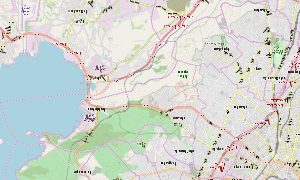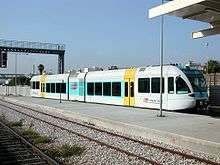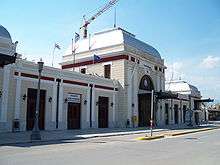Athens railway station
Athens railway station (Greek: Σιδηροδρομικός Σταθμός Αθηνών, romanized: Sidirodromikós Stathmós Athinón) is the main railway station of Athens, the capital city of Greece, and the largest station of the country. It is located in the central quarter of Kolonos. It resulted from the merger of the city's two main railway terminals, the Larissa Station (Greek: Σταθμός Λαρίσσης) of the Piraeus–Platy railway line towards central and northern Greece, and of the Peloponnese Station (Greek: Σταθμός Πελοποννήσου, Stathmós Peloponnísou) of the Piraeus–Patras railway line linking Athens with the southern Peloponnese peninsula. The station is still colloquially known as "Larissa Station", which is also the name of a Metro station there.
| ||||||||||||||||||||||||||||||||||||||||
|---|---|---|---|---|---|---|---|---|---|---|---|---|---|---|---|---|---|---|---|---|---|---|---|---|---|---|---|---|---|---|---|---|---|---|---|---|---|---|---|---|
 View of the station building (2019) | ||||||||||||||||||||||||||||||||||||||||
| Location | Domokou Avenue, Kolonos Athens, Greece | |||||||||||||||||||||||||||||||||||||||
| Coordinates | 37°59′32.24″N 23°43′14″E | |||||||||||||||||||||||||||||||||||||||
| Owned by | OSE | |||||||||||||||||||||||||||||||||||||||
| Line(s) | Piraeus–Platy railway | |||||||||||||||||||||||||||||||||||||||
| Platforms | 6 (3 operational) | |||||||||||||||||||||||||||||||||||||||
| Tracks | 10 (4 operational) | |||||||||||||||||||||||||||||||||||||||
| Train operators | TrainOSE | |||||||||||||||||||||||||||||||||||||||
| Connections | ||||||||||||||||||||||||||||||||||||||||
| Construction | ||||||||||||||||||||||||||||||||||||||||
| Platform levels | 2 | |||||||||||||||||||||||||||||||||||||||
| Parking | Yes | |||||||||||||||||||||||||||||||||||||||
| Bicycle facilities | No | |||||||||||||||||||||||||||||||||||||||
| Disabled access | ||||||||||||||||||||||||||||||||||||||||
| Other information | ||||||||||||||||||||||||||||||||||||||||
| Status | Staffed | |||||||||||||||||||||||||||||||||||||||
| Website | https://www.ose.gr/en/ | |||||||||||||||||||||||||||||||||||||||
| History | ||||||||||||||||||||||||||||||||||||||||
| Opened | 8 March 1904 | |||||||||||||||||||||||||||||||||||||||
| Electrified | 25 kV AC | |||||||||||||||||||||||||||||||||||||||
| Services | ||||||||||||||||||||||||||||||||||||||||
| ||||||||||||||||||||||||||||||||||||||||
| Location | ||||||||||||||||||||||||||||||||||||||||

Location within West Athens | ||||||||||||||||||||||||||||||||||||||||
| Line structure | ||||||||||||||||||||||||||||||||||||||||||||||||||||||||||||||||||||||||||||||||||||||||||||||||||||||||||||||||||||||||||||||||||||||||||||||||||||||||||||||||||||||||||||||||||||||||||||||||||||||||||||||||||||||||||||||||||||||||||||||||||||||||||||||||||||||||||||||||||||||||||||||||||||||||||||||||||||||||||||||||||||||||||||||||||||||||||||||||||||||||||||||||||||||||||||||||||||||||||||||||||||||||||||||||||||||||||||||||||||||||||||||||||||||||||||||||||||||||||||
|---|---|---|---|---|---|---|---|---|---|---|---|---|---|---|---|---|---|---|---|---|---|---|---|---|---|---|---|---|---|---|---|---|---|---|---|---|---|---|---|---|---|---|---|---|---|---|---|---|---|---|---|---|---|---|---|---|---|---|---|---|---|---|---|---|---|---|---|---|---|---|---|---|---|---|---|---|---|---|---|---|---|---|---|---|---|---|---|---|---|---|---|---|---|---|---|---|---|---|---|---|---|---|---|---|---|---|---|---|---|---|---|---|---|---|---|---|---|---|---|---|---|---|---|---|---|---|---|---|---|---|---|---|---|---|---|---|---|---|---|---|---|---|---|---|---|---|---|---|---|---|---|---|---|---|---|---|---|---|---|---|---|---|---|---|---|---|---|---|---|---|---|---|---|---|---|---|---|---|---|---|---|---|---|---|---|---|---|---|---|---|---|---|---|---|---|---|---|---|---|---|---|---|---|---|---|---|---|---|---|---|---|---|---|---|---|---|---|---|---|---|---|---|---|---|---|---|---|---|---|---|---|---|---|---|---|---|---|---|---|---|---|---|---|---|---|---|---|---|---|---|---|---|---|---|---|---|---|---|---|---|---|---|---|---|---|---|---|---|---|---|---|---|---|---|---|---|---|---|---|---|---|---|---|---|---|---|---|---|---|---|---|---|---|---|---|---|---|---|---|---|---|---|---|---|---|---|---|---|---|---|---|---|---|---|---|---|---|---|---|---|---|---|---|---|---|---|---|---|---|---|---|---|---|---|---|---|---|---|---|---|---|---|---|---|---|---|---|---|---|---|---|---|---|---|---|---|---|---|---|---|---|---|---|---|---|---|---|---|---|---|---|---|---|---|---|---|---|---|---|---|---|---|---|---|---|---|---|---|---|---|---|---|---|---|---|---|---|---|---|---|---|---|---|---|---|---|---|---|---|---|---|---|---|---|---|---|---|---|---|---|---|---|---|---|---|---|---|---|---|---|---|---|---|---|---|---|---|---|---|---|---|---|---|---|---|---|---|---|---|---|---|---|---|---|---|---|---|---|---|---|---|---|---|---|---|---|---|---|---|---|---|---|---|---|---|---|
| ||||||||||||||||||||||||||||||||||||||||||||||||||||||||||||||||||||||||||||||||||||||||||||||||||||||||||||||||||||||||||||||||||||||||||||||||||||||||||||||||||||||||||||||||||||||||||||||||||||||||||||||||||||||||||||||||||||||||||||||||||||||||||||||||||||||||||||||||||||||||||||||||||||||||||||||||||||||||||||||||||||||||||||||||||||||||||||||||||||||||||||||||||||||||||||||||||||||||||||||||||||||||||||||||||||||||||||||||||||||||||||||||||||||||||||||||||||||||||||
History
Inaugurated on 29 June 1904, the station was named after the city of Larissa, as the southern terminal of the line to the Thessalian city and Thessaloniki. The older adjacent station, Stathmós Peloponnísou (Σταθμός Πελοποννήσου, 37°59′22.6″N 23°43′9.52″E), was inaugurated on 30 June 1884, named after the Peloponnese peninsula due to its services to the region. Closed on 7 August 2005, along with the Piraeus-Agioi Anargyroi line, its activities since then moved to the Stathmos Larissis.[1] Regarding the metro station, part of the Line 2, it is an underground stop inaugurated on 28 January 2000. On 4 June 2017 the last service departed the un-modernized section of the Athens railway station, having been closed for modernization that took over the Peloponese railway station.
Structure
Larissa Station has a large, two-floor building in front of a square Domokou avenue, in which there are some platforms for bus services. Currently (Spring 2019) in use are 3 platforms and 4 tracks. The whole station is under reconstruction for modernization and enlargement[2]: the station will be improved with 12 tracks and 7 platforms and the line electrified.[3] Construction of the new platforms (9 and 10) and tracks, located where the goods yard of Peloponnese station was, is complete.[4]
Services
The station is served by Line 2 of the Athens Metro and by three Proastiakos suburban services: Piraeus–Athens Airport, Piraeus–Kiato and Athens–Chalcis. It also serves as the terminus for the regional service to Leianokladi, the express service to Kalambaka and the InterCity service to Thessaloniki.
During the twentieth century, especially in the first half, Athens station was the terminus for some international trains, such as an Express to Berlin (departing from the former Anhalter Bahnhof) or the "Arlberg"[5] route of the Orient Express (London-Athens via Paris-Zürich-Vienna-Budapest-Belgrade-Skopje), in service until 1962 and then of the Direct Orient Express (Paris-Lausanne-Venice-Ljubljana-Zagreb-Belgrade-Skopje) until 1976.[6]
Future
Being under construction since 2005 and having faced many delays, the station's expansion promises to significantly increase its capacity and increase the number of platforms.
Gallery
 View of station platforms in 1979
View of station platforms in 1979 A Proastiakos suburban train at the station
A Proastiakos suburban train at the station An Alstom first generation EMU train of Athens Central Metro Station 15 February 2010
An Alstom first generation EMU train of Athens Central Metro Station 15 February 2010 The "Peloponnisou" station building 3 June 2007
The "Peloponnisou" station building 3 June 2007
See also
References
- "Athens Guide: Trains in Greece". www.athensguide.com. Retrieved 3 April 2018.
- Drone view of the station and the construction works, July 2017
- "Railway map of Greece, showing also lines under electrification works". Retrieved 3 April 2018.
- New platforms in use in the Athens central railway station, Article in construction online magazine ypodomes.com (in Greek), 07/07/2017
- See map on Commons
- "Darstaed TP - gauge '0' tin plate trains - Your stop for a ride through the past". www.darstaed.com. Retrieved 3 April 2018.
External links
![]()